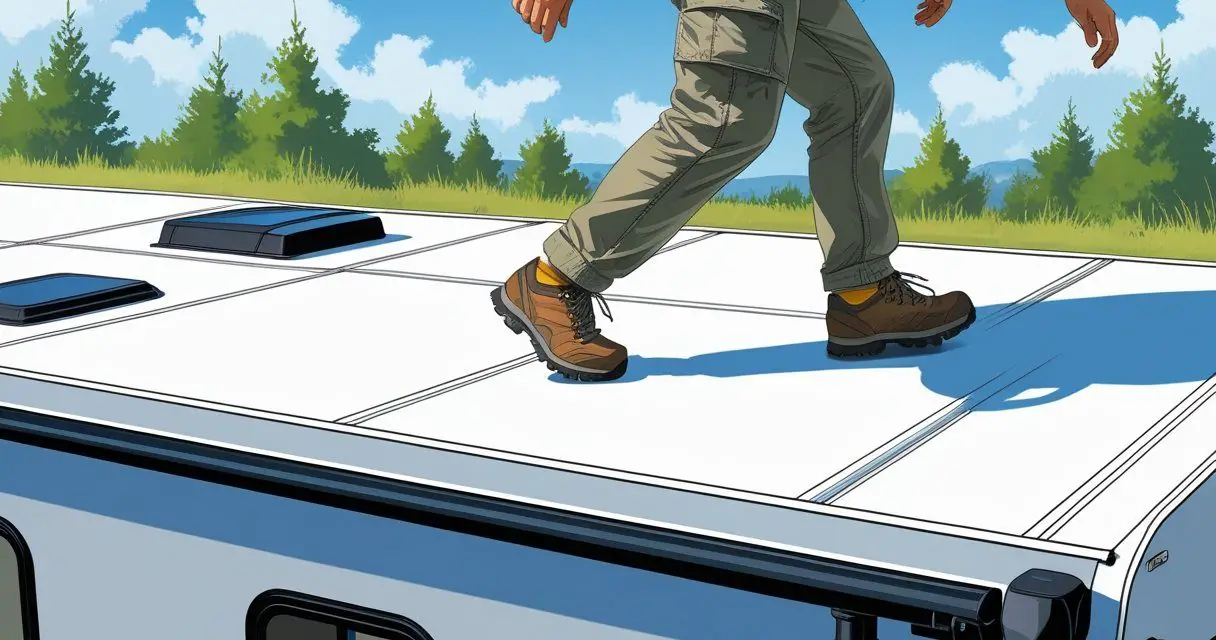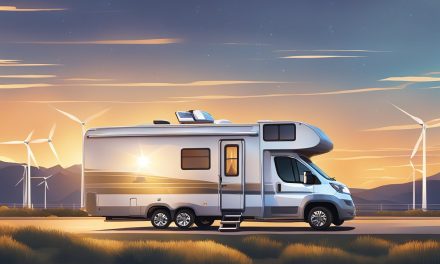Would you like to save this article?
Walking on your Keystone RV roof isn’t always as simple as climbing up and stepping across. Some models are built to handle light foot traffic for cleaning and inspections, while others are not designed for it at all.
Whether you can safely walk on your roof depends on the specific model and how it was constructed.
You need to know what type of roof your Keystone RV has before taking that step. Fiberglass roofs often provide better support, while certain wood or metal frame designs may only handle limited weight.
Ignoring these differences can lead to costly damage or even personal injury. Understanding where you can safely step and how to move across the surface makes all the difference.
With the right knowledge, you can handle inspections, maintenance, and cleaning without risking damage to your RV or yourself.
Key Takeaways
- Know your RV roof type before stepping on it
- Walk only when the roof design supports foot traffic
- Use safe techniques to protect both you and the roof
Determining If Your Keystone RV Roof Is Walkable
Not every Keystone RV roof is designed to hold a person’s weight. The ability to walk on it depends on the roof’s construction, the presence of support features, and the manufacturer’s stated guidelines.
Manufacturer Guidelines and Weight Limits
The most reliable way to know if your Keystone RV roof is walkable is to check the manufacturer’s documentation. Keystone provides weight ratings for many of its models, and these limits vary based on roof design.
Some are rated for a single adult, while others are labeled no-walk roofs. Most RV roofs support around 200–250 pounds, but this is not universal.
Your exact model may have a different limit. If you exceed the rating, you risk structural damage or voiding your warranty.
When in doubt, call Keystone directly with your model information. Ask for the roof’s maximum load capacity and whether it is intended for foot traffic.
Identifying Factory-Installed Roof Ladders
A simple way to check if your Keystone RV roof is walkable is to look for a factory-installed ladder. Keystone typically installs ladders only on models with roofs designed to support weight.
If your RV has a ladder attached at the rear, it usually means the roof can handle at least one adult for maintenance tasks. However, this does not mean unlimited use or heavy loads are safe.
If no ladder is present, the roof may not be designed for walking. In that case, you should avoid climbing up unless you use plywood or planks to distribute your weight and reduce stress on the roof panels.
Model Variations and VIN Inquiry
Keystone builds many different RV models, and not all share the same roof construction. For example, some Passport units have no-walk roofs, while larger fifth wheels may include reinforced structures.
Because of these differences, you should use your VIN (Vehicle Identification Number) when contacting Keystone. The VIN allows the company to identify the exact build of your RV, including the roof type and its walkability rating.
This step is especially important if you bought your RV used or do not have the original owner’s manual. It provides a direct answer about whether your specific roof can safely support you.
Understanding Keystone RV Roof Construction
The design of your Keystone RV roof affects how much weight it can handle, how long it lasts, and whether it is safe for you to walk on it. The type of roofing material, the support structure underneath, and the way the roof is built all play an important role.
Common Roof Materials Used in Keystone RVs
Keystone RVs often use TPO (Thermoplastic Olefin) or EPDM (Ethylene Propylene Diene Monomer) membranes. These are flexible rubber-like materials that protect the roof from water and UV damage.
Both require routine inspection and resealing around seams and vents. Some higher-end Keystone models feature a fiberglass RV roof.
Fiberglass is more rigid and durable than TPO or EPDM. It usually resists punctures better and can handle light foot traffic more reliably.
However, fiberglass can still crack if stressed by heavy weight or sharp impacts. Another factor is the thickness of the roof decking under the membrane.
Even when the material itself is strong, a thin or weak deck may not support your weight. This is why the same roofing surface can behave differently depending on the model.
Structural Support and Roof Decking
Beneath the roof membrane, Keystone RVs use either wood framing or metal framing. Wood framing often consists of 1×1 or 2×2 rafters, while metal framing uses lightweight steel trusses.
The spacing between these supports determines how much weight the roof can hold. The decking material, usually plywood or OSB (Oriented Strand Board), is fastened to the frame.
Thicker decking provides a sturdier surface, while thin panels may flex under pressure. You should also consider how the decking is attached—glued and stapled panels may not be as strong as screwed or reinforced panels.
If you notice sagging or soft spots when pressing on the roof, the support structure may already be weakened. In that case, walking on it could cause damage or even collapse.
Differences Between Walkable and Non-Walkable Roofs
Not every Keystone RV roof is designed to be walked on. Walkable roofs typically have closely spaced rafters, thicker decking, and stronger membranes like fiberglass.
These designs allow you to safely access the roof for cleaning or maintenance. Non-walkable roofs often use lighter framing and thinner decking.
While they can support mounted equipment such as air conditioners or solar panels, they are not intended to hold the full weight of an adult. Walking on them may cause cracks, punctures, or structural failure.
A quick way to check is to review your owner’s manual or contact Keystone with your VIN. This gives you exact details about the roof’s construction and its rated weight capacity.
Types of RV Roof Materials and Their Walkability
Different RV roof materials handle weight and foot traffic in different ways. The strength of the surface, the type of support underneath, and how the roof is maintained all affect whether you can safely walk on it.
Fiberglass RV Roof Strengths and Weaknesses
A fiberglass RV roof is usually one of the most durable options. Fiberglass is molded into a solid sheet, which gives it fewer seams and a smoother surface.
This reduces the risk of leaks and makes it easier to clean. You can often walk on fiberglass roofs because they distribute weight more evenly.
Many higher-end Keystone RV models use this type for its strength. Still, you should confirm the roof’s weight rating since not all fiberglass builds are the same.
The main drawback is weight and cost. Fiberglass is heavier than other materials, which can add to overall RV weight.
Repairs can also be more expensive if cracks form. If you choose to walk on it, wear shoes with good grip and avoid standing near edges where support is weaker.
Rubber and TPO Roof Characteristics
Rubber-based roofs, such as EPDM (Ethylene Propylene Diene Monomer) or TPO (Thermoplastic Olefin), are common on Keystone RVs. These membranes are flexible, lightweight, and cost-effective.
They resist UV damage fairly well, but they require regular inspections for tears, punctures, or failing sealant. Walking on a rubber or TPO roof is possible if the roof decking underneath is strong.
The material itself does not provide structural support. Instead, plywood or OSB panels beneath the membrane bear the load.
If the decking is thin or spaced too far apart, soft spots can form. You should avoid dragging tools or wearing rough shoes on these surfaces.
The membranes can scuff or tear more easily than fiberglass. Using a kneeling pad or spreading your weight with a small board can protect the material when you need to perform maintenance.
Aluminum Roof Considerations
An aluminum RV roof is less common today but still found on some models. Aluminum panels are lightweight, resist cracking, and hold up well against sun exposure.
They also reflect heat, which can help keep the RV cooler. Walking on an aluminum roof depends on the frame underneath.
The panels themselves are thin and can dent under pressure. If the roof uses closely spaced supports, it may handle foot traffic better, but dents are still possible.
Another factor is noise. Aluminum roofs can creak or pop when walked on, which may be unsettling but not always a sign of damage.
To reduce risk, step carefully and avoid carrying heavy loads across the surface. Regular inspections for loosened seams or fasteners are important since movement can cause gaps over time.
Safety Precautions for Walking on Your RV Roof
Walking on your Keystone RV roof requires careful steps to avoid damage and reduce the risk of injury. You need to manage how your weight is spread, where you step, and the condition of the surface before climbing up.
Weight Distribution Techniques
Your RV roof is not designed to support concentrated pressure in one spot. To reduce strain, spread your weight across a larger area.
Moving on your hands and knees instead of standing upright helps distribute load more evenly. You can also use a ½ sheet of plywood or a wide wooden board to create a stable platform.
Place it flat on the roof so your weight is supported across multiple beams rather than one panel. For fiberglass RV roofs, this step is even more important.
Fiberglass can crack under sharp pressure points, especially if you weigh more than 250 lbs. Using foam pads or soft knee pads also protects the surface from scratches while keeping you more stable.
Avoiding Weak Spots and Roof Components
Not every part of the RV roof is built to hold your weight. The strongest areas usually run along the roof trusses or near the edges where framing provides extra support.
Avoid stepping on thin sections between supports. These areas may flex or bow, which can damage the roof membrane.
Stay clear of roof components such as AC units, vents, skylights, antennas, and seals. These parts are not designed to hold weight and can break or leak if stepped on.
If you need to work near them, place a board across the roof to bridge over weak sections.
Weather and Surface Conditions
The condition of the roof surface changes how safe it is to walk. A wet or icy roof becomes slippery, even if it is rated as walkable.
Always check the weather and wait for a dry surface before climbing up. Heat can also affect materials.
On hot days, rubber or fiberglass RV roofs may soften slightly, making them more prone to dents or marks. Wearing non-slip shoes with soft soles helps reduce the chance of slipping and prevents scuffing the roof.
If you must work in damp conditions, use a safety harness and secure ladder. This reduces the risk of falls and gives you more control while moving across the roof.
Proper Techniques for Accessing and Moving on the Roof
When you need to access your Keystone RV roof, safety and weight distribution matter most. Using the right tools, stepping carefully, and spreading your weight across stronger areas reduces the risk of damage and injury.
Recommended Tools and Equipment
Always use a stable ladder rated for your weight. Place it on level ground and secure it to prevent shifting.
A telescoping ladder works well if your RV doesn’t have a built-in ladder. Wear non-slip shoes with soft soles to avoid slipping and to protect the roof membrane.
Avoid sandals, boots with hard treads, or anything that could puncture the surface. A safety harness anchored to a secure point gives extra protection against falls.
Even though RV roofs are lower than house roofs, a slip can still cause serious injury. Keep a tool belt or small backpack so your hands stay free when climbing.
Carrying tools in your hands while on a ladder increases the chance of losing balance.
Best Practices for Climbing and Stepping
Climb slowly and face the ladder at all times. Keep three points of contact—two hands and one foot, or two feet and one hand.
Once on the roof, walk near the edges where the walls provide more support. The center sections between trusses are weaker and may flex under pressure.
Avoid stepping near skylights, vents, or the air conditioner. These areas are fragile and not designed to hold weight.
Distribute your steps evenly and move with short strides. Standing in one spot for too long puts unnecessary stress on the roof surface.
If the roof is wet or icy, wait until conditions improve. Fiberglass and rubber membranes become slippery, making accidents more likely.
Using Plywood or Foam Boards for Support
Placing ½-inch plywood panels or rigid foam boards across multiple trusses spreads your weight over a wider surface. This reduces the chance of puncturing the roof membrane or cracking the plywood underneath.
Cut panels into manageable sizes (about 2×4 feet) so they’re easy to move as you work. Position them under your knees or feet when you need to stay in one area.
If you’re installing solar panels or sealing seams, kneel or lay on the board instead of standing directly on the roof. This keeps pressure low and prevents dents or soft spots from forming.
Using boards also helps protect older RV roofs where materials may have weakened over time.
Maintenance and Inspection Tips for Keystone RV Roofs
Keeping your Keystone RV roof in good condition requires steady attention. You need to check for wear, clean away buildup, and catch small issues before they cause leaks or costly repairs.
Routine Roof Inspection Procedures
Inspect your Keystone RV roof at least twice a year and after long trips. Use a stable ladder and walk carefully if your model allows roof access.
If your RV does not have a factory ladder, assume the roof is not designed for walking. Look closely at seams, vents, skylights, and edges.
These areas are most likely to develop cracks or loose sealant. Carry a flashlight to spot small gaps or lifted material.
Create a checklist to stay consistent:
- Check sealant condition
- Inspect roof membrane for punctures
- Look for soft spots underfoot
- Verify that roof accessories are secure
Cleaning and Debris Removal
Clean your RV roof at least every three months or more often if parked under trees. Use a soft-bristle brush and a cleaner approved for your specific roof material, such as TPO or rubber.
Avoid harsh chemicals that can damage the membrane. Remove branches, leaves, and dirt since they trap moisture and can stain or weaken the roof.
Rinse thoroughly with a hose but avoid high-pressure washers, which may loosen sealant or seams. Pay attention to gutters and downspouts if your Keystone RV is equipped with them.
Keeping these clear prevents water from pooling and reduces the risk of leaks.
Identifying Signs of Roof Damage
Check for early signs of damage during every inspection. Common issues include:
- Cracked or peeling sealant
- Bubbles or blisters under the roof membrane
- Discoloration that may signal water intrusion
- Loose or missing screws on roof-mounted equipment
Press gently on suspect areas. A soft or spongy feel often means water has entered the roof structure.
Inspect the inside of your RV ceiling for stains or dampness, which can confirm a leak.
Reseal seams with compatible products and tighten loose hardware. Waiting too long can allow water damage to spread into insulation, rafters, or walls.





